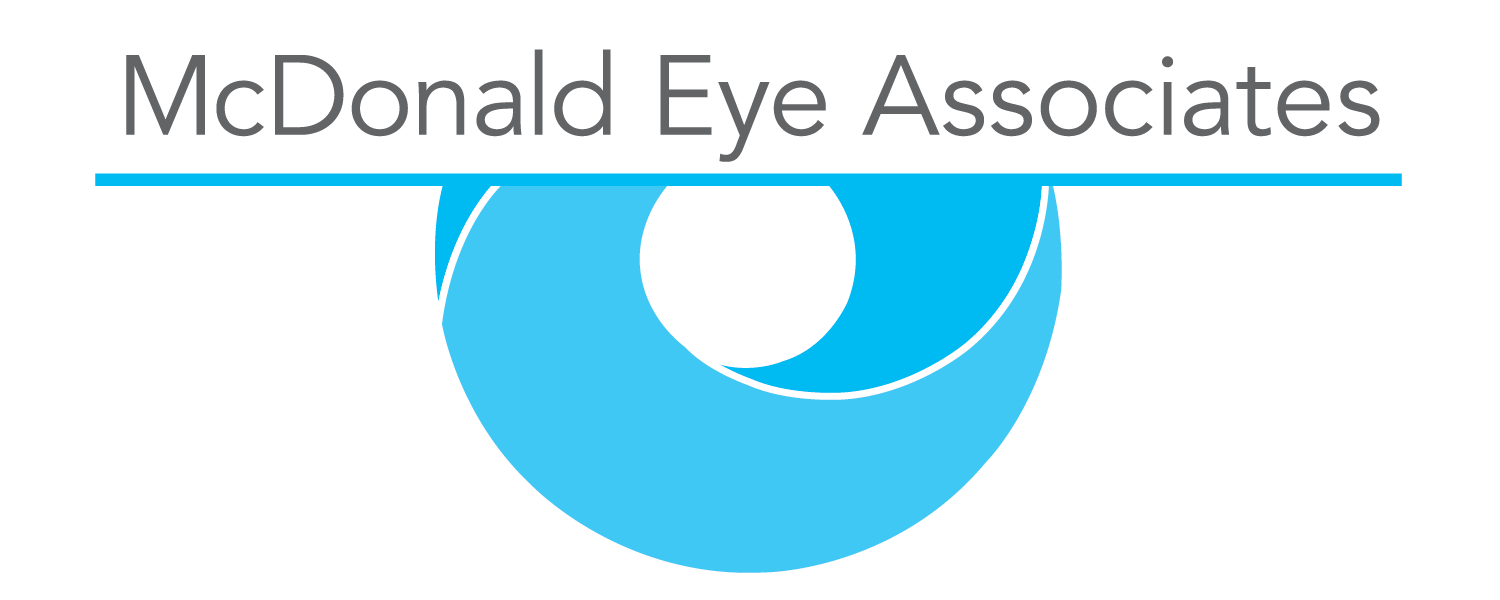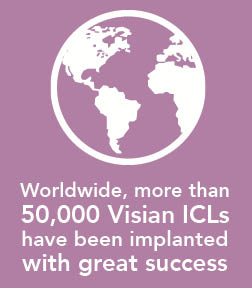Many nearsighted patients who are not candidates for LASIK vision correction, and even some patients whose vision does not allow them to wear contact lenses, can benefit from implantable contact lenses. McDonald Eye Associates uses the advanced Visian™ ICL (Implantable Collamer Lens).
The Visian ICL has been successfully implanted overseas for years, but it only recently received FDA approval. McDonald Eye Associates is pleased to offer this breakthrough technology to highly nearsighted patients.
What is it?
The Visian™ ICL is a small, foldable lens that is placed inside the eye to improve focusing power. The lens is positioned behind the eye’s iris (the colored portion of the eye), where it cannot be seen with the naked eye.
The lens remains in place in the eye without maintenance, although it can be easily removed or replaced by the surgeon if your needs change. One of the principle benefits of the Visian ICL over other implantable lenses is the material used to make it: Collamer®. Made primarily of collagen, Collamer® is very compatible with the human body and extremely unlikely to cause adverse side effects.
The Visian™ ICL Procedure
One to two weeks prior to surgery, your McDonald Eye Associates surgeon will use a laser to make a small opening within your eye that allows fluid to pass between the eye’s lens and the front of the eye. This will not affect your vision.
On the day of your surgery, your McDonald Eye Associates surgeon will first numb your eyes with anesthetic drops. Next, he will make an incision so tiny that it closes without stitches; competing technology requires an incision at least twice as large. A gel-like substance is then injected into the eye, followed by the Visian™ ICL. The procedure itself is brief and painless, much like LASIK. It takes about 15 minutes and is performed while you remain awake and relaxed (you may be given a mild sedative to alleviate nervousness).
Once the Visian™ ICL has been gently moved behind the iris, the gel is removed. The incision will heal naturally in a short amount of time. You will be allowed to return home shortly after the procedure; because you will not be allowed to drive immediately after the procedure, you should make arrangements to have a friend or family member bring you home.
Is it right for me?
The Visian ICL is designed to improve the vision of very nearsighted individuals, reducing and in many cases eliminating the need for glasses and contact lenses. Your surgeon and the staff of McDonald Eye Associates will need to perform tests to determine if the lens is a good fit for you.
Seeing the Benefits
Worldwide, more than 50,000 Visian ICLs have been implanted with great success. In the U.S. clinical trial, the patient satisfaction rate was very impressive: 99.4 percent reported satisfaction three years after receiving the lens. Three years after receiving the Visian ICL, 95 percent of patients in the clinical trial had 20/40 vision, the benchmark for passing the driver’s test, without the aid of glasses or contacts.
Frequently Asked Questions
Is the Visian ICL visible to others?
No. The Visian ICL is positioned behind the iris (the colored part of the eye), where it is invisible to both you and observers. Only your surgeon will be able to tell that vision correction has taken place.
What type of procedure is involved in implanting the Visian ICL?
The surgical procedure to implant the Visian ICL is simple and painless. As a Visian ICL candidate, the surgeons at McDonald Eye Associates will prepare your eyes one to two weeks prior to the procedure by using a laser to create two very small openings in the colored part of your eye which lies between the lens and the front chamber of your eye. This allows for the natural passage of fluids between the two areas, thereby avoiding the buildup of intraocular pressure following the treatment.
The implantation procedure itself takes about 15 minutes and is performed on an outpatient basis, though you will have to make arrangements for someone to drive you to and from the procedure.
You can expect to experience very little discomfort during the Visian ICL implantation. You will undergo treatment while under a light topical or local anesthetic, perhaps with the addition of a mild sedative. Following surgery, you may use prescription eye drops or oral medication. The day after surgery, you will return to McDonald Eye Associates for a follow-up visit. You will also have follow-up visits one month and six months following the procedure.
What if my vision changes after I receive the Visian ICL?
One advantage of the Visian ICL is that it offers treatment flexibility. If your vision changes dramatically after receiving the implant, your surgeon can remove and replace it. If necessary, another procedure can be performed at any time.
Patients can wear glasses or contact lenses as needed following treatment with the Visian ICL. The implant does not treat presbyopia (difficulty with reading in people 40 and older), but you can use reading glasses as needed after receiving the Visian ICL.
How do I know if I’m a suitable Visian ICL candidate?
Candidates for the Visian ICL are between 21 and 45 years of age, suffer from myopia (nearsightedness), and want to experience superior vision correction. The ideal Visian ICL candidate has not undergone any ophthalmic surgery and does not have a history of eye disease such as iritis, glaucoma, or diabetic retinopathy.
Anyone seeking clearer vision may be a Visian ICL candidate, including those with special or extreme vision correction needs. Consumers should contact McDonald Eye Associates for more information, including an assessment of their candidacy.
Patients without enough anterior chamber depth or endothelial cell density may not be a good Visian ICL candidate.




